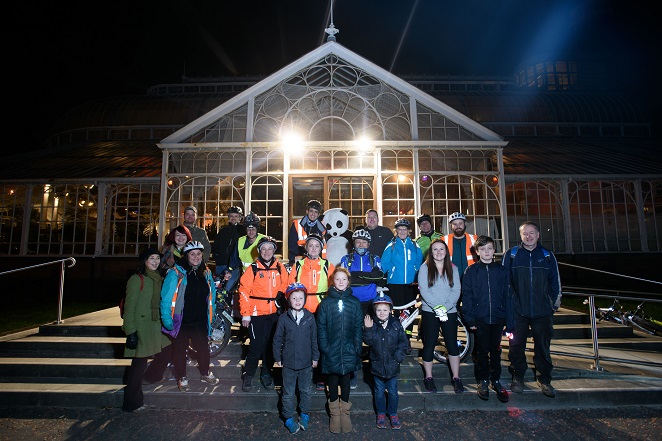120 Scottish landmarks took part in WWF's Earth Hour on Saturday -here are pictures from those, and from the 3,000 others around the world which took part
Lights went out around the world at the weekend as an unprecedented 187 countries and territories took part in the 10th Earth Hour on Saturday.
More than 3,000 landmarks switched off their lights at 8.30pm (their local time) and millions of individuals, businesses and organisations across seven continents stepped forward in a bid to demonstrate how much they want to play a part in tackling climate change as part of the WWF-organised event.
In Scotland, the iconic Forth Bridge was the focal point as it was plunged into darkness along with 119 other iconic landmarks including Edinburgh Castle, the Kelpies and Inverness Cathedral.
The Scottish Parliament, Buchanan Galleries, University of St. Andrews and the Wallace monument in Aberdeen also turned off their lights for the hour.
Above: Lights out at the Forth Bridge
All 32 local authorities signed up to turn the lights off in their offices and 25 public bodies were also involved.
Over 1,000 schools signed up to take part and 50 community events the length and breadth of the country were organised by volunteers with the help of partners from YoungScot and Eco-Congregations Scotland.
Lang Banks, director of WWF Scotland, declared Earth Hour 2017 a success in Scotland and called on those who took part to now go beyond the hour and take on year round actions on climate change.
"Earth Hour is a great way to encourage people to start thinking about the effects climate change is having here and elsewhere around the world,” he said.
Above: Coliseum of Rome
"It's been the hottest year on record for the third year in a row and nearly one in six species are now at risk of extinction from climate change.
“The world is changing fast so it's never been more important to show that you care.”
Originally started as a one-city event in Sydney a decade ago, Earth Hour has grown year on year as more people attempt to put pressure on governments and big businesses by highlighting issues such as renewable energy, the need for sustainable lifestyles, biodiversity protection and the need for stronger climate policy.
Above: Sydney Opera House and Harbour Bridge
This year, #EarthHour and other related terms generated over 1.1 billion impressions online in 24 hours, trending in at least 30 countries worldwide.
In Australia the Sydney Opera House fell dark, as did the Tokyo Tower in Japan, the Empire State Building in New York, the Pyramids of Egypt and the Eiffel Tower in Paris.
“Once again, the people have spoken through Earth Hour,” said Sid Das, executive director, of Earth Hour Global.
“Whether you are in the Philippines, Peru or Portugal, climate change matters and the record participation in this year’s Earth Hour is a powerful reminder that people, who are on the frontline of climate change, want to be a part of climate action.
Above: Acropolis of Athens
“From the shrinking of Arctic ice to coral reef bleaching, there are clear indicators that we are pushing our planet to the edge - and it is together as a global community that we can turn it around.
“The grassroots must mobilize and join governments and companies toward stronger climate action - the time to act is now.”
As well as just switching off their lights for an hour many countries used Earth Hour to promote campaigns.
In Aberdeenshire, the council announced it is the first local authority in Scotland to implement a carbon budget meaning that each of its services will be allocated an annual carbon total and forced to reduce it year on year.
Above: Big Ben and the Houses of Parliament
In the Highlands the Eden Court theatre in Inverness got schoolchildren to create posters and short videos to promote a special screening of environmental film How to Let Go Of The World And Love All Things Climate Can’t Change.
Further afield, in India thousands were encouraged to make the switch to renewable energy and LED lighting and in Poland and Bulgaria, people united to protest against laws and policies that threaten biodiversity.
Celebrities and social influencers from around the world also joined in to promote Earth Hour this year including WWF global ambassadors Andy Murray, Jared Leto and Ellie Goulding.
In a video for Earth Hour, UN secretary-general Antonio Guterres reiterated the need for people to work together to build a sustainable, climate-resilient future.
He added: “Climate change continues to imperil lives and livelihoods around the world.
“From the darkness we can create a sustainable and inclusive world for all.”
Who took part in Scotland

- 120 landmarks
- All 32 local authorities
- 1000 schools
- 25 public bodies involved
- 50 community events arranged
Pictured: The People's Palace and Winter Garden, Glasgow






